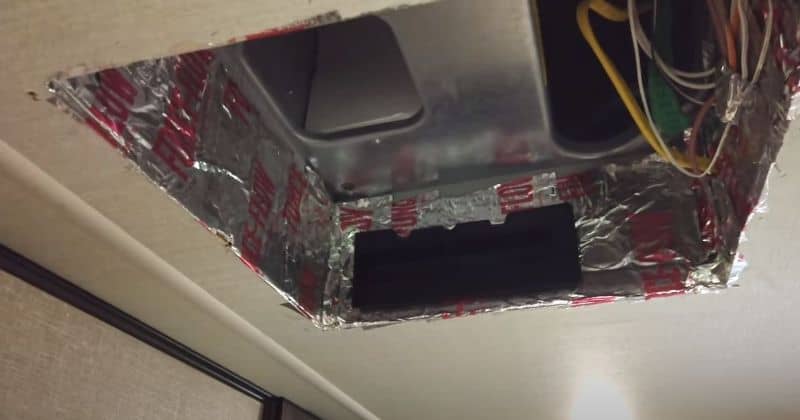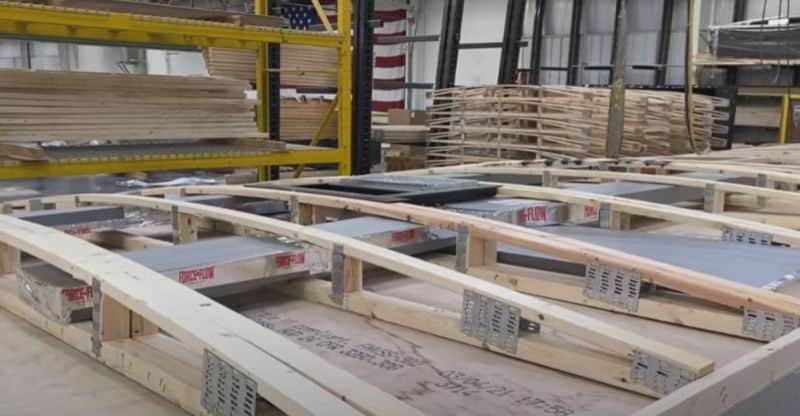Recently, I saw the results of a poll by RVLifestyle.com asking RV owners, “What features do you want in your next RV?” Number five by popularity was “ducted air conditioner.” For a split second, that surprised me. Why would RV owners care about their mechanical innards?
And then I realized “Oh … it’s about the noise!”
***
I’m tackling this topic because too often RV buyers don’t even think about the mechanicals until after they’ve made a purchase. And if you’re a light sleeper or resident of anywhere hot (rapidly becoming the entire U.S.), that’s a major mistake.
What’s the Difference Between a Ducted or Non-Ducted RV Air Conditioner?
Somewhat confusingly, the difference has nothing to do with the air conditioner itself. Almost all RV rooftop air conditioners can be configured for either ducted or non-ducted (direct) use.
Instead, the difference is how air is circulated within the RV.
You can imagine the contrast like the difference between a window air conditioner and central A/C.
A window A/c is an all-in-one unit. It pulls in warm air in the same spot it blows out cold air. So it doesn’t move around the cold air very much. It just recycles the air in the room around it.
I’ve lived in several houses like this. In one rental house, I had only a single thru-the-wall air conditioner in the bedroom, which was shut off from the rest of the house by an L-shaped hallway. Come May, my wife disappeared into the bedroom, and I didn’t see her again until September.
Meanwhile, a central air conditioner splits up the system via ducts. Returns are separated from vents, which promotes better air circulation and distribution.
That’s why a single air conditioning unit can cool your entire 2-story house. It’s all thanks to the ducts, plenums, registers, vents, and other HVAC magic that directs and controls the flow of air.
In summary:
- A non-ducted RV air conditioner simply blows cold air directly out of the unit
- A ducted system distributes the cold air through the roof or floor ducts.

Why Do People Prefer Ducted RV Air Conditioners?
We’ll get into the arguments for energy efficiency in a minute. The real reason most people prefer a ducted air conditioner is for the noise, noise, noise! (to quote The Grinch).
In a (non-ducted) direct vent system, cold air is forced out of the A/C with a condenser fan. Noise emanates from the spinning fan blades, from the rush of air over the condenser coils, and from the turbulence of the air as it passes through the distribution box.
All that exposed air movement is noisy.
How noisy?
Glad you asked!
Why Are RV Air Conditioners So Noisy?
As I said, a lot of noise comes from turbulent air movement.
Other sources of noise include:
- Noisy compressor
- Rigid compressor mounts (or loose vibration isolators)
- Unbalanced fan blades
- Fan blade vibration
And that’s just on new A/Cs! Old air conditioners can suffer from loose vibration isolaters, bad bearings, dirty filters, etc. See my guide to troubleshooting RV rooftop air conditioners for more hints and information.
Some RV air conditioners come with dB ratings, but actual sound volume varies widely depending on the installation itself! For instance, an air conditioner in a small room surrounded by hard surfaces will sound much louder than that same air conditioner in a large room with carpet and cushions.
It’s not uncommon for a non-ducted RV air conditioner to reach 65-75 dB on High. That’s way beyond comfortable for interior noise levels, which is 50-55 dB.
The RV aftermarket actually does a lot of business selling quieter air conditioners. You can replace your stock A/C with:
- Furrion Chill
- Coleman-Mach Quiet Series
- RecPro/Houghton Quiet
Or you can look into aftermarket products like the RV A/C Silencer.
Is a Ducted RV Air Conditioner More Energy-Efficient?
You would think, as an RV engineer, I would know the answer to this question, wouldn’t you?
Unfortunately … reality doesn’t always match up to theory.
The theory is pretty simple:
On paper, a ducted RV air conditioner is more efficient because the return vents are separate from the supply vents. So cold air blows out one side of the room and warm air gets sucked in the other side.
- The ducts evenly distribute the cold air throughout the interior, even with doors closed.
- Better distribution eliminates pockets of cold air, which can confuse your thermostat.
- Louvered vent covers allow you to create cooling “zones” within your RV.
- Low-profile return shrouds eliminate the 3” thick direct-vent distribution boxes on which you can easily wack your head!
If you’re lucky enough to have an under-floor or mini split air conditioner, then the ducts may be run through your floor. However, these are usually only available on luxury 5th wheels and motorhomes.
Such is the theory on ducted RV air conditioners. But like I said, sometimes, reality doesn’t quite match up. Haphazard design or poor installation can cause problems.
The air conditioning ducts are very thin, just a few inches tall. They are typically run through your roof trusses, as shown here:

During installation, these ducts can get crushed (especially at the joints). These ducts can also leak at the seams, allowing cold air to escape into your attic.
Another common problem is the design of the air conditioner plenum or distribution box.
Some OEM air conditioners just spew the cold air directly into a cube-shaped air plenum connected at a right angle to a lateral duct. If you know anything about fluid dynamics, you know right angles just cause a lot of wasted turbulence and very little useful motion!
That’s where solutions like RV Airflow Systems come into play. By maintaining smooth, laminar flow, you get better air discharge and faster cooling.
I’m seeing more and more of these improvements from OEMs, such as Grand Design’s adoption of the RV Airflow Systems plenum, the Jayco Helix ducting system, or the Atwood Air Command V-Flow diverter plenum.

(Sorry it’s taken so long!)
But don’t misunderstand me. Even with all their failure modes, ducted RV air conditioners are generally more energy-efficient and much quieter than direct-vented air conditioners.
If you’re interested in energy-efficient air conditioners, I wrote a whole article about them here!
Can I Switch to a Ducted RV Air Conditioner?
system … you are out of luck.
Unless you perform major invasive surgery on your RV, you can’t easily add ductwork into your roof or floor.
And if you’re shopping for an entry-level trailer, you might need to request a ducted A/C as an option.
If you’re sick and tired of your current A/C, I would recommend trying an aftermarket “silencer” product first. Or sell your air conditioner on Ebay and buy a better one. Even a 5-10 dB change can make a huge difference when you’re trying to sleep!
And that’s where most people draw the line. Most RVers can tolerate a direct air conditioner in a living space, but very few want a non-ducted air conditioner in their bedroom!
Leave a Reply